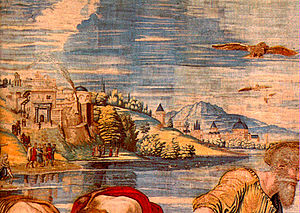Vatican hill
| Vatican hill | ||
|---|---|---|
|
The Vatican Hill on a tapestry from around 1519 |
||
| height | 75 m | |
| location | Vatican city | |
| Coordinates | 41 ° 54'13 " N , 12 ° 27'1" E | |
|
|
||
| Type | hill | |
| rock | Tufa | |
| particularities | Highest mountain in the Vatican | |
The Vatican Hill ( Latin : mons Vaticanus ) is a hill in the Vatican City , consisting mainly of tuff stone , which is located near the right bank of the Tiber . Its height is 75 meters, making the hill the highest point in the Vatican.
Ancient and early Middle Ages
The plain at the foot of the hill (between Monte Mario in the north and the Gianicolo in the south) was called ager vaticanus ("Vatican field") in ancient times . Summer villas were built there during Republican times .
After the cult of the Great Mother Cybele in 204 BC. Was introduced in Rome, a sanctuary of the Cybele and Attis cult, the so-called Phrygianum , was built on the mons Vaticanus . A certain central position in the Cybele cult is indicated by the fact that congregations outside Rome could also designate their sanctuary as mons Vaticanus . An inscription from Mainz-Kastel , dated August 23, 236, reports that the cult association of the “spear-bearers” of the Mattiakers had restored the “ mons Vaticanus, who collapsed from old age ” in honor of the goddess Bellona (= Cybele). It is believed that the mons Vaticanus was a grotto sanctuary in Mainz-Kastel as well as in Rome. Such a grotto sanctuary was possibly located under the current St. Peter's Basilica, because during the expansion of this church in 1608/09 a number of beautifully crafted altars of the Cybele and Attis cults emerged from the earth, which can be seen today in the Vatican Museum.
Emperor Caligula had a circus built on the southern slope of the Vatican Hill, outside the former city wall . According to tradition suffered there Petrus in 64 or 67 under Emperor Nero the martyrdom . He was buried in a cemetery north of the Circus (where Christians, pagans and Jews were buried). Part of the hill was demolished under Constantine to build the first St. Peter's basilica over the presumed tomb of the apostle (326). Parts of this ancient burial ground form the Vatican necropolis below St. Peter's Basilica. The Vatican thus became the central place of pilgrimage for the veneration of Peter. In the following centuries, more buildings arose on the hill, especially so-called scholae , which offered pilgrims of different nationalities accommodation, chapels and cemeteries, but also had fortifications. Under Leo IV , larger fortifications were built around the entire pilgrimage site in the middle of the 9th century (including the Leonine Wall, which is partially preserved to this day ).
Late Middle Ages and Modern Times
The Vatican only became the seat of the Pope and the administration of the Curia at the end of the 14th century, when the Popes returned from exile in Avignon after the schism . Before that, the popes resided in the Lateran Palace.
Today the Vatican Museums , the Vatican Gardens and the Papal Palace are located on the hill . The entire hilltop is surrounded by walls and forms the territory of the independent state of the Vatican City .
literature
- Clemens Jöckle , Georg Denzler : The Vatican. History - Art - Meaning , Darmstadt, Primus Verlag 2006, ISBN 978-3-89678-573-2

